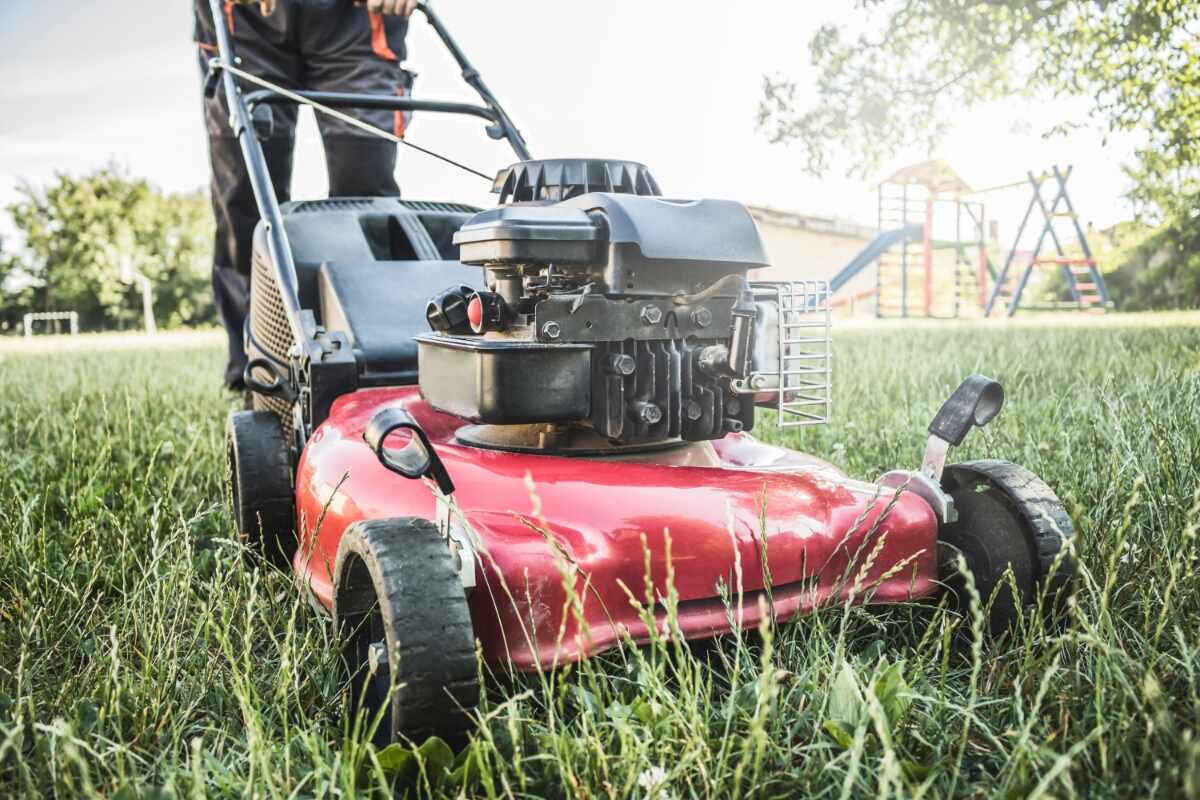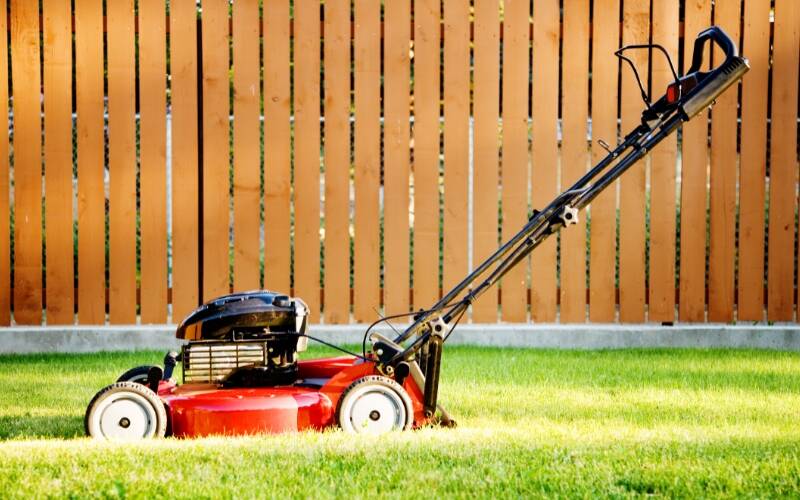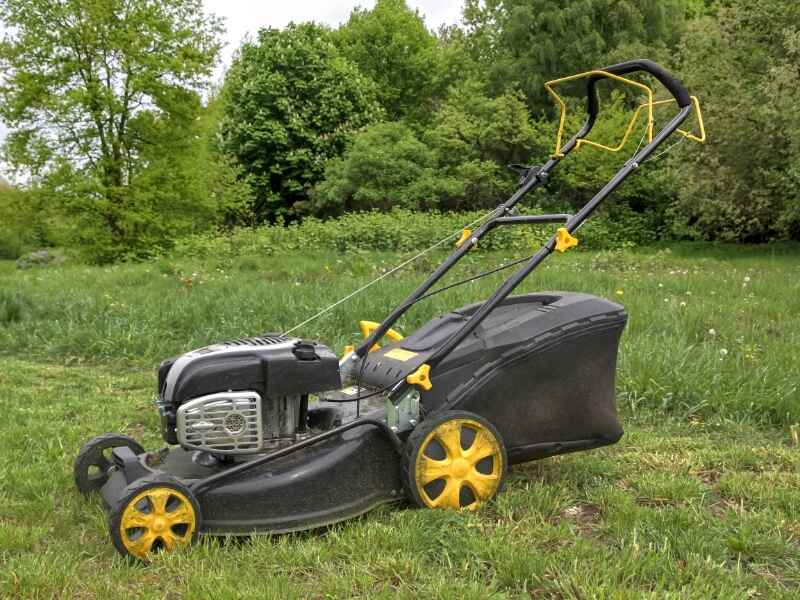
Self-propelled lawn mowers combine the benefits of a push mower with the technology used in vehicles. When the engine is running, and the drive system is engaged, the lawn mower propels itself across the lawn, cutting down on the physical force needed to move the machine. They significantly cut down on the time and effort involved in cutting grass.
Interested in learning more about self-propelled lawn mowers? You’ve come to the right place! This article will tell you everything you need to know about self-propelled lawn mowers, including the pros and cons, different types, and how to choose the right one for you.
How Does a Self-Propelled Mower Work?

A self-propelled mower works almost like any push-behind gas or battery-powered mower. Once the engine is on and the blades under the cutting deck are engaged, the mower starts cutting grass.
However, these lawn mowers also implement a drive system similar to how your car operates. The mower propels itself forward when the engine runs and the drive system is engaged. This means you don’t have to put physical force into pushing it from behind; all you need to do is steer it, which transforms a laborious outdoor chore into a much simpler and enjoyable experience.
The mechanics are similar regardless of whether you’re using a gas or battery-operated mower. After the engine starts, you’ll use a drive lever to propel the mower forward. The exact mechanism depends on the mower’s brand.
For example, I have a Honda self-propelled push mower. To use the self-propelled feature, I push down on a paddle-like attachment connected to the center of the handlebar. The further it’s pushed down, the faster the mower moves. When I release the paddle, the mower stops.
Pros and Cons of a Self-Propelled Lawn Mower
Pros
✓ Takes less physical effort to mow
✓ Easier on your body
✓ Saves time
✓ Mows more efficiently through thick grass
✓ Easier to mow uneven terrain
✓ Results in a smoother, more uniform cut
Cons
✗ More expensive to purchase
✗ Heavier
✗ Less maneuverability
✗ More expensive to maintain or repair
Different Types of Self-Propelled Mowers
Similar to the drive train on a vehicle, there are three types of self-propelled mowers: all-wheel drive, front-wheel drive, and rear-wheel drive. The best self-propelled lawn mower for you will depend on your personal preference as well as key factors such as warranty, cutting widths, durability, and price.
Type 1: All-Wheel Drive (AWD)
An all-wheel-drive mower is similar to putting your truck in four-wheel-drive. All four wheels are powered by the drive system, giving the mower excellent, balanced traction. Depending on your needs and the terrain you’re covering, you can often switch between AWD, front-wheel, and rear-wheel drive.
These mowers are typically more expensive than the other drive systems and aren’t as readily available in retail stores.
Type 2: Front-Wheel Drive (FWD)
A front-wheel-drive system is typically the least expensive of the three types, but it isn’t conducive to every type of lawn. This type of lawn mower is best for small yards, flat lawns, and even terrains.
So, let’s talk physics for a minute to understand better why an FWD system isn’t great for bumpy lawns. If your lawn is uneven or filled with holes, the front wheels will bounce as your mower moves across it. When the front wheels bounce and come up off the ground, you’ll lose the propulsion the self-propelled feature provides.
All in all, this isn’t bad, but it will mean you’ll be putting in a little more muscle when you cut your grass. Any time the front wheels come off the ground (e.g., turning, going up an incline, or hitting a hole the dog dug), you must supply the force to keep the mower mowing forward.
Type 3: Rear-Wheel Drive (RWD)
Rear-wheel drive is the most popular of the three self-propelled mower types. It is ideal if you have an uneven or sloping lawn or are cutting a larger area. The RWD system provides excellent traction and takes very little physical force to move rear-wheel drive mowers across most terrain.
Plus, unlike a FWD system, you’ll still have propulsion if the front wheels come off the ground while circling trees or turning the corner to start a new row. So you’ll save energy and put less physical strain on your body.
Features to Look For in a Self-Propelled Lawn Mower

If you’re in the market for a new mower, here are some handy features you may want to consider when looking at self-propelled models.
Mower Speed Control
As you shop, see whether the mower you’re contemplating has a single or variable-speed drive system.
A single-speed mower moves at one constant speed regardless. These types work well for a standard walking pace across an even lawn.
A variable-speed mower lets you adjust the speed and allows for more flexibility in how fast you’re walking. The ability to change the speed is helpful if you mow across hills, around trees, or through dense grass.
Electric Start
All battery-powered mowers have an electric or push-button start option, making it incredibly simple to fire up your mower. Some self-propelled gas lawn mowers have the option, but they are harder to find.
However, if you have limited upper body strength or shoulder problems, looking for something with a push-button start may be helpful. The pull start mechanism on a gas-powered mower can be a challenge, to say the least.
Power Source
Self-propelled lawn mowers come in both corded and cordless varieties, each with its own set of advantages. Cordless models are typically powered by lithium-ion batteries, offering greater freedom of movement without the constraints of a power cord. This makes them ideal areas where access to power outlets is limited.
On the other hand, corded self-propelled mowers need to be plugged in, which can restrict mobility to a certain extent. However, they provide the benefit of continuous power without the need for recharging, making them a good choice for smaller yards.
Grass Disposal Options
Most mowers give you a minimum of two different grass disposal options: you can bag or mulch your clippings. Some self-propelled mowers also have a side discharge chute on the mower, which helps to spread clippings evenly and prevent clumping.
Blade Brake Clutch
A blade brake clutch lets you shut the blades off but keeps the mower running. This feature is handy if you need to empty the bag of grass clippings, pick up toys or obstacles in the lawn, or cross a gravel path or paved walkway.
Single-Lever Height Adjustment
There are times during the season when you might want to adjust the cutting deck height on your mower. Especially if you’ve let the grass grow a little too long and are following the rule of only removing one-third of the blades any time you mow. To make it easier to adjust the height, some mowers have a single level that adjusts all four wheels.
This feature saves time and ensures the mowing height is always the same from side to side and front to back.
Fold-and-Store Capability
If you’re limited on storage space in your garage or shed, look for a mower that folds up for easy winter storage. In most cases, regardless of the power source, there is a mechanism on the handlebars that allows them to fold into a more compact configuration. Some electric lawn mowers can stand upright when not in use.
FAQ
Does a Walk Behind Lawn Mower Mean Self-Propelled?
No, a walk-behind mower doesn’t necessarily mean it’s self-propelled. Lawn mowers are typically classified as walk-behind versus riding lawn mowers. Walk-behind mowers are then categorized as either push or self-propelled mowers.
With a push mower, the operator uses their physical strength and force to push it around the yard. With a self-propelled mower, the machine is powered by a transmission, requiring little to no physical force from the operator to move it across the lawn.
Is it OK to Push a Self-Propelled Mower?
Yes, you can certainly push a self-propelled mower without using the propel feature. Keep in mind that since they are designed to power themselves forward, the drive train is built such that it will require more physical force to push it than a standard push mower.
How Long Do Self-Propelled Mowers Last?
Many manufacturers rate the longevity of their mowers based on a set number of service hours or run time. But you can expect a self-propelled mower to last eight years or more, depending on how often it is used and how well it’s maintained. (Most manufacturers rate their mowers for a set number of service hours.) There’s no real difference in service life between a self-propelled and a standard push lawn mower.
Here are a few additional resources to help you maintain your lawn mower:
- DIY Lawn Mower Maintenance Guide
- How to Change the Oil in a Lawn Mower in 9 Steps
- How to Change Spark Plugs on a Lawn Mower
- How to Clean and Change a Lawn Mower Air Filter in 9 Steps
- How to Sharpen Lawn Mower Blades
Need Help Mowing Your Lawn?
We get it. Sometimes, mowing your lawn is a more significant task than you’re willing to take on, even with a self-propelled mower to make the job easier. This is why Lawn Starter is always here to help!
If you’re looking for a high-quality lawn professional to help keep your lawn mowed and looking beautiful or for other landscaping needs, give us a call or use our online contact form. We’ll put you in touch with the best local lawn care services!
Main Photo Credit: Dony / Canva Pro / License